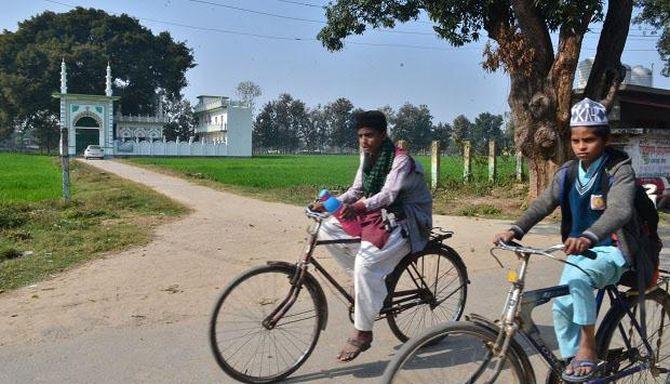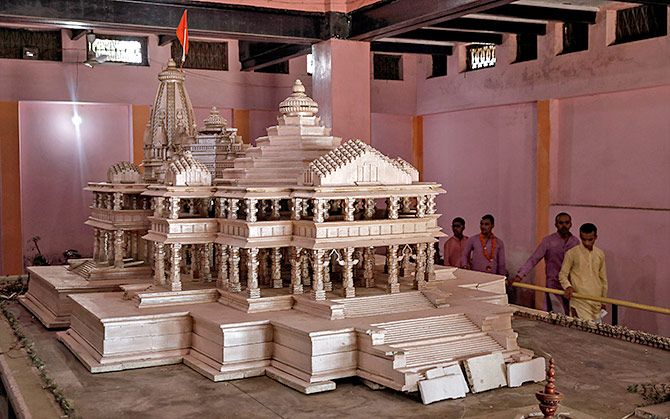 | « Back to article | Print this article |
Iqbal Ansari, one of the main plaintiffs who fought for the right of the community over the disputed land, says Muslims in Ayodhya won't be satisfied if the Sunni Waqf Board accepts the five acres in Dhannipur.
Ritwik Sharma reports.

Until some days ago, the people of Dhannipur had no inkling that the replacement for the demolished Babri Masjid would be in their backyard.
Now, they are getting used to the media attention and are welcoming, with cautious optimism, the prospect of hosting a shrine that may put the village on the international map.
Mohammad Shamim, a 70-year-old farmer, is hopeful of an end to the communal strife that flared up after the Babri Masjid -- a 16th-century mosque said to be built on the orders of the Mughal emperor Babur -- was razed by kar sevaks in December 1992.
"This is also Ayodhya (district). If the government allotted land in Ayodhya city, there might be another fight. We want the tussle to end," he says, stepping out of a mosque after offering the afternoon namaz.
"It's up to the government what kind of mosque it wants to build here. But if it is named after Babur, it might draw more visitors."
Dhannipur is in the Sohawal tehsil of Ayodhya (formerly Faizabad district), about 25 km from the disputed site and on the Lucknow-Gorakhpur highway.
Last month, Prime Minister Narendra Damodardas Modi told Parliament that the Centre had decided to set up a trust for building the Ram temple in Ayodhya.
It was followed by the Uttar Pradesh cabinet approving a proposal to allot five acres to the state Sunni Central Waqf Board for construction of a mosque as ordered by the Supreme Court in the Ram Janambhoomi-Babri Masjid title dispute case on November 9 last year.
Soon afterwards, a team of government officials, including the lekhpal, or village accountant, of the revenue department came to inspect and measure the five acres.
The patch chosen is on government-owned farmland with the most luxuriant green wheat crops.
A gleaming white mausoleum with green-and-gold motifs stands in the middle of the site, which is a stone's throw from the Raunahi police station on the highway.
The mazar houses the tomb of Shahgada Shah Rahmat Ullah Alaih, a Sufi saint whose death anniversary (urs) is celebrated at the end of April with a three-day festival that includes qawwalis and horse races.
Dhannipur is a Muslim-majority village with a population of around 2,000 that also includes Yadavs and scheduled castes.
It is reported to have 22 mosques.
Mohammad Shahid, a meat seller in adjoining Raunahi village, also looks forward to a new "Babri Masjid".
The two villages lie on either side of the farmland allocated as the site for the mosque.
"We feel it is a good step. We couldn't go to the Babri Masjid earlier. The new mosque should be named after Babur only," he says.
Ruksana Banu, a 58-year-old resident, says that for three days last week there was a lot of anticipation as officials descended on Dhannipur, with media personnel in tow.
"But there has been no follow-up. We can't have a say in this. The mosque will be built if the Sunni Board decides," she says.
For most youths, however, bread-and-butter issues are more pressing than a mosque.
Shahbaz Khan, 28, who owns a cloth store in Sohawal, says there are enough mosques in Dhannipur.
"Masjid jyada hai lekin namazi hain hi nahi. Gunehgar toh hum hai dharm ke hisab se (There are plenty of mosques, but hardly anyone offers prayers. By religious standards, we are guilty)," he smiles.
Along with a mosque, the authorities should also set up a graduate college and a public hospital, he says.
"Children have to go to Faizabad to enrol in colleges. There is a government hospital in Sohawal, but it's not in good shape."
None of the villagers I spoke to failed to point out that Dhannipur has always been an example of communal harmony.
It is like a mantra, and a helpful reminder to one and all.

Ram Krishan Yadav, who is in his 50s, says there was never any communal discord in the village even after the Babri demolition.
He iterates that education and health care need more attention, although he has no complaint against the building of a mosque.
"The mosque may lead to some development as more people may visit here. Otherwise politicians do not care beyond the kursi (chair). They rake up a mandir-masjid issue, grab power and forget about vikas (development)."
Yadav is an example of the appeal that the Ram Janambhoomi movement -- the culmination of which will be the construction of the Ram temple at the site where the Babri Masjid stood -- has for the average Hindu beyond the city of Ayodhya.
"India belongs to Hindus," he says. "Ayodhya is a religious foundation and the birthplace of Ram. So the temple should be built there."
At Ayodhya's Hanuman Garhi, a popular temple on the hillock where the disputed 2.77 acres is also located, Raju Das performs a daily yagna so that the Ram mandir is built soon.
The senior priest of the Hanuman Garhi recently accused the Vishva Hindu Parishad of not including Ayodhya seers in the new temple trust.
The trust, which will operate from New Delhi and frame rules on its properties and funds, will have 15 members.
There were muted grumblings among the seers over the members of the trust.
Nritya Gopal Das, president of the Ram Janmabhoomi Nyas which is run by the VHP, also expressed displeasure at being excluded, prompting the Bharatiya Janata Party to pacify him.
Paramhans Das of the Tapasvi ki Chawni temple sat on a fast after his proposal to name Rashtriya Swayamsevak Sangh chief Mohan Bhagwat as head of the trust went unheeded.
Raju Das says that most sadhus are unhappy about the non-inclusion of a representative of the Vaishnav Samaj.
"It was no doubt a court case, but the government should have included them in the trust. Sadhus were a bit upset, but they are accepting it. Now, the focus should be on a grand temple," he says.
The priest's words appear practised as he repeatedly thanks and congratulates the government and the people, and labels those opposed to the Ram Janambhoomi movement -- and the new citizenship law-- as elements who play politics over religion.
Faint discontent apart, sadhus and priests in Ayodhya anticipate that work on the temple will start on Ram Navami which will be in the first week of April this year.
Raju Das says the sadhus want the temple to accommodate 100,000 devotees, apart from a revamp of the smaller temples and transportation facilities within the 67 acres of land that the Centre has acquired.
After the final hearing in the case, a Supreme Court bench gave a unanimous judgment in favour of the Ram Janambhoomi.
In an earlier ruling in 2010, the Allahabad high court had ordered that the disputed 2.77 acres be divided equally between the three parties -- the Nirmohi Akhara; Ram Lalla Virajman, the infant deity represented by the Ram Janambhoomi Nyas; and the Sunni Waqf Board.
The judgment and the allotment of land for the mosque outside the city have drawn a mixed response, ranging from quiet acceptance to harsh criticism from Muslim leaders and parties involved in the dispute.
All India Majlis-e-Ittehadul Muslimeen chief Asaduddin Owaisi termed the court's verdict a victory of faith over facts and the alternative patch of land an insult to the minority community.
While some have sought to review the Supreme Court order, more recently the offer of the land in Dhannipur has irked everyone because of its distance from Ayodhya.
They have also put pressure on the Sunni Waqf Board to move the Supreme Court.
The All India Muslim Personal Law Board emphasised that the Sunni Waqf Board did not represent the entire community.
The VHP and the fraternity of sadhus had been demanding that land for the mosque be granted outside the 14 kosiparikram -- a radius around Ayodhya town that devotees circle during religious events. (One kos is roughly 3 km.)

Paramhans Das says that according to Hindu traditions, a pilgrim centre ought to debar unholy or profane practices within an "84 kosiparikrama".
In Ayodhya, "84 kosiparikrama" and "5 kosiparikrama" are held too. But Das claims the large-hearted sadhus didn't demand that land be allocated for a mosque named after an "invader" outside the "84 kosiparikrama".
Khaliq Ahmad Khan, a nominee of litigant Maulana Mahfoozur Rahman, a native of Ayodhya, argues that the court decision as well as the allocation of land in Dhannipur go against positions held earlier by the court and the government.
"S B Chavan, who was the home minister then, said in Parliament in 1993 that a complex will be set up that will include a temple, mosque, library, hostel, et cetera. Where are these now? It's nothing but fraud and lies," he says.
The central government had acquired the 67-odd acres in and around the disputed site through the Ayodhya Act, 1993.
Iqbal Ansari, one of the main plaintiffs who fought for the right of the community over the disputed land, says Muslims in Ayodhya won't be satisfied if the Sunni Waqf Board accepts the five acres in Dhannipur.
He points out that there are well over 30 mosques and twice as many graveyards in Ayodhya city.
Five acres may be hard to come by within municipal limits.
Therefore, he argues, a smaller plot would also be acceptable to the locals.
"The Supreme Court asked the government to offer land in a prominent place in the city. We are asking for only that."
Next to his home in Kotia Mohalla, a few hundred metres away from the disputed site, is an ancient mausoleum made of stone.
A few steps away is a mosque.
Both are named after a saint called Bijli Shaheed.
A lane separates the two buildings from a graveyard.
Ansari has suggested to the Sunni Waqf Board that this mosque be redeveloped so that it can house a thousand devotees, from around 200 at present.
The government could acquire the land further up the lane leading to the main road, and offer it to the community to build a women's hospital and a dharamshala, he says.
For good measure, he adds: "We don't need to associate Babur's name with the mosque. He was an emperor, not a messiah. And we don't worship emperors."